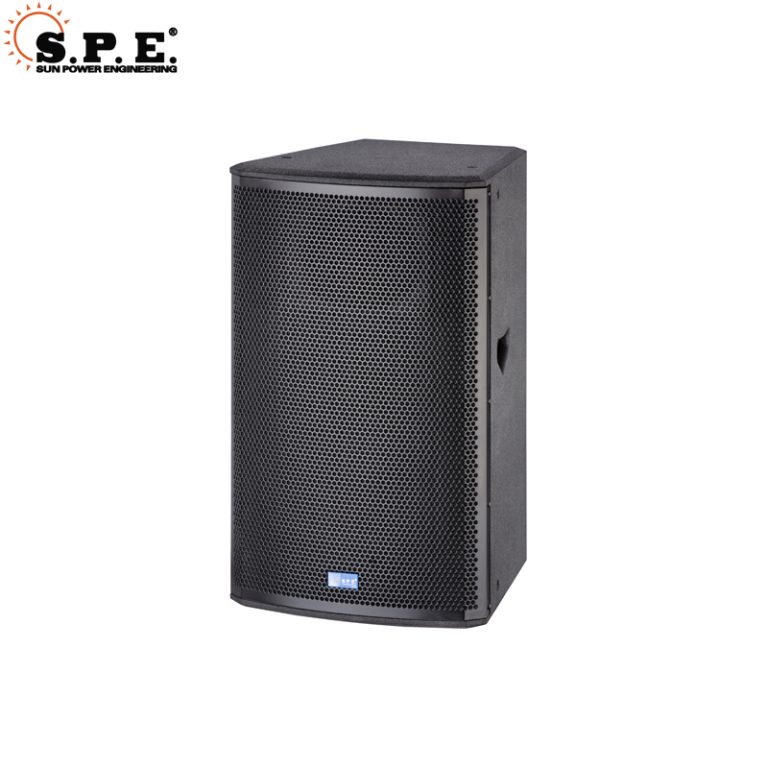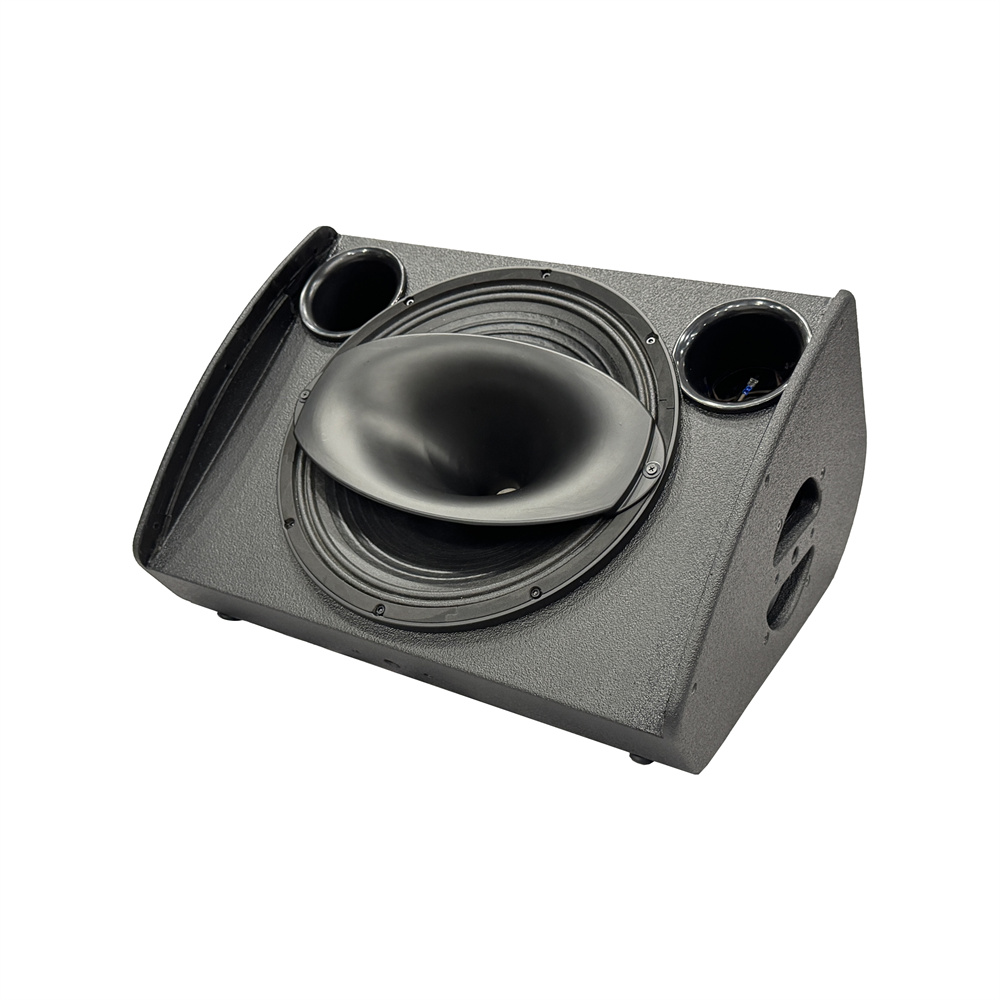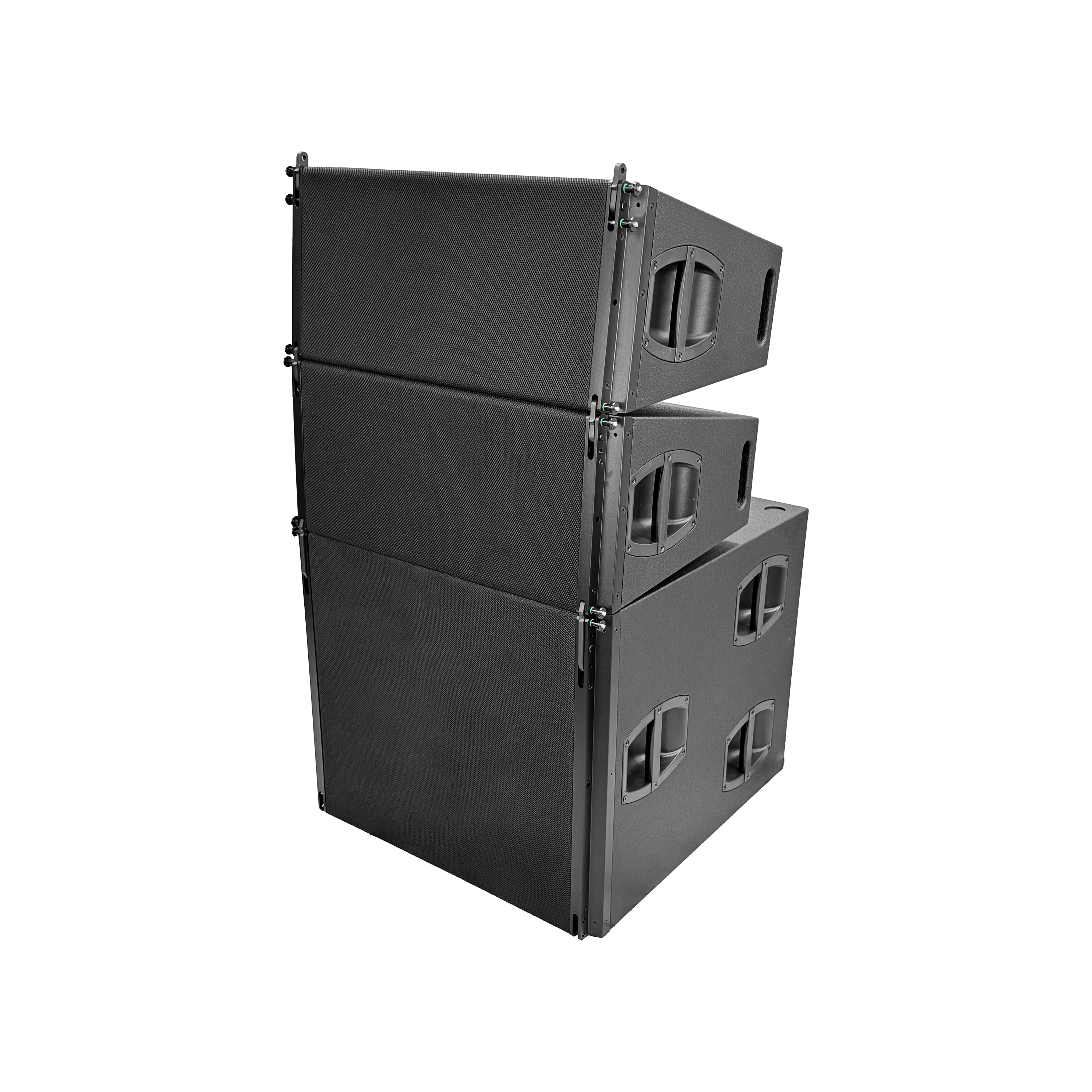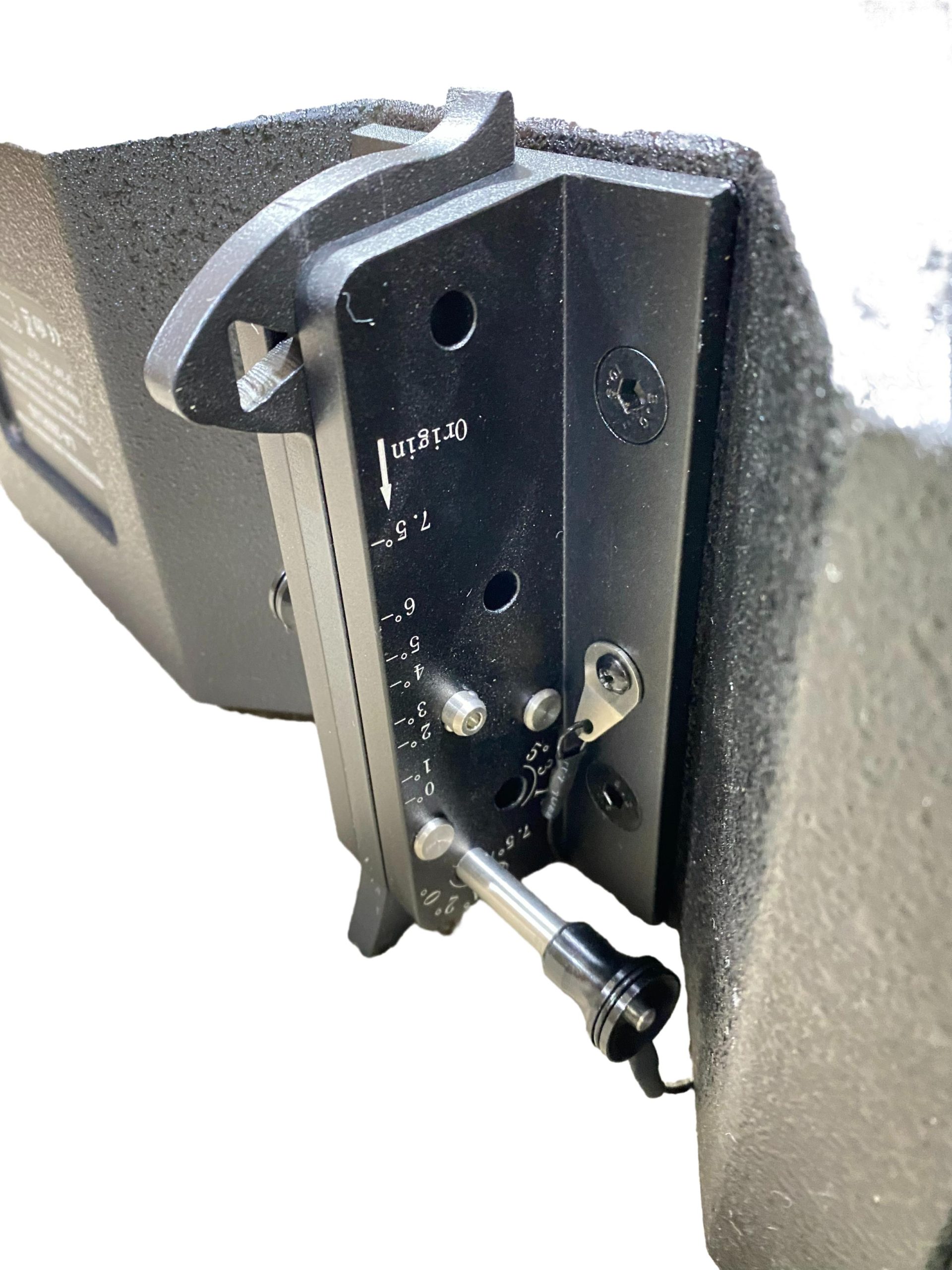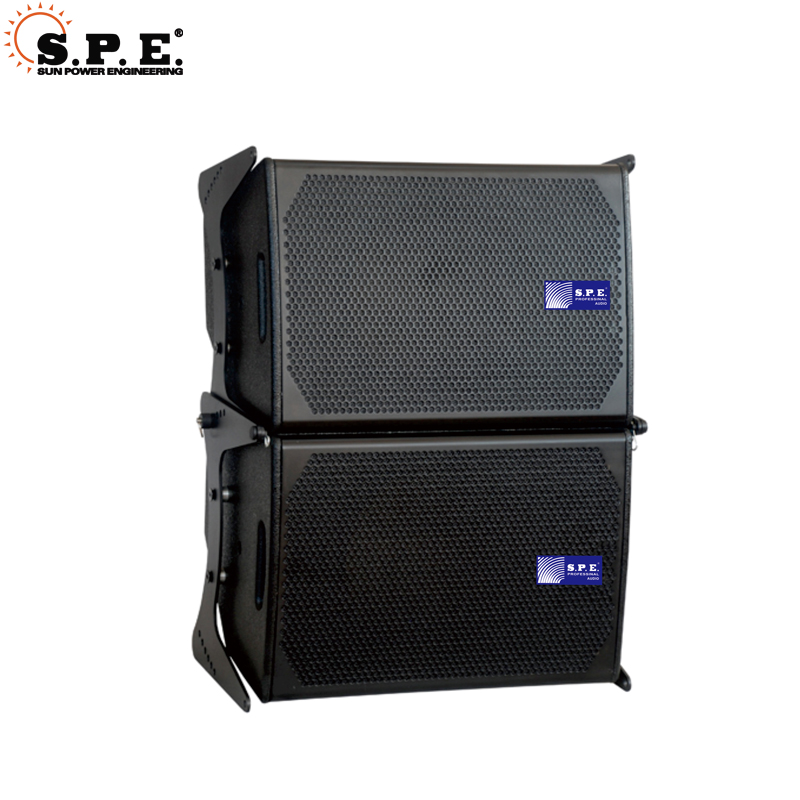Одиночные 12-дюймовые линейные массивы сочетают в себе мощь традиционных 12-дюймовых низкочастотных динамиков со специализированной технологией линейного массива, обеспечивая сфокусированное дальнее звучание. Эти компактные системы заполняют пробел между крупными линейными массивами и небольшими точечными акустическими системами, делая профессиональное звукоусиление доступным для площадок среднего размера.

Один 12-дюймовый линейный массив обычно оснащен 12-дюймовым низкочастотным динамиком в паре с компрессионными драйверами с узкой диаграммой направленности, что позволяет объединять несколько устройств для улучшения покрытия и управления звуком. The NOVA C112 обеспечивает мощность 450 Вт RMS с охватом 100° по горизонтали и 10° по вертикали, в то время как такие системы, как CH120 оснащен импортными динамиками для оптимизированной частотной характеристики.
Профессиональные звукорежиссёры выбирают эти системы за их универсальность как для стационарных инсталляций, так и для гастрольного использования. Технология обеспечивает точное управление направленностью, что снижает нежелательные отражения и обеспечивает стабильное качество звука во всей зоне прослушивания. Это делает их идеальными для площадок, где традиционные линейные массивы могут оказаться слишком громоздкими.
Ключевые выводы
- В отдельных 12-дюймовых линейных массивах используются специализированные низкочастотные динамики и компрессионные драйверы, обеспечивающие узкую вертикальную дисперсию и масштабируемое покрытие.
- Эти системы обычно работают с мощностью 400–500 Вт RMS и обеспечивают максимальный уровень звукового давления около 130–137 дБ для профессионального применения.
- Они отлично подходят для площадок среднего размера, диджейских систем, корпоративных мероприятий и инсталляций, где полномасштабные линейные массивы не нужны.
Основные компоненты и технологии одного 12-дюймового линейного массива
Системы линейного массива с одним 12-дюймовым динамиком сочетают в себе точную акустическую инженерию, особые технологии динамиков и методы усиления. Для достижения оптимального звукового покрытия такие системы требуют тщательной интеграции нескольких динамиков, высококачественных материалов и правильного распределения мощности.
Конфигурация линейного массива громкоговорителей
Один 12-дюймовый линейный динамик использует 2-х или 3-х полосная конструкция для работы в разных диапазонах частот. C112 одноканальный 12-дюймовый полнодиапазонный линейный массив имеет компактную 2-полосную конфигурацию с зоной покрытия 100° x 10°.
В большинстве систем 12-дюймовый низкочастотный динамик располагается в нижней части корпуса. Компрессионный драйвер расположен над ним в специально разработанном волноводе.
Ключевые элементы конфигурации включают в себя:
- Вертикальное соединение между несколькими шкафами
- Точная регулировка угла направления звука
- Интегрированное такелажное оборудование для безопасной установки
- Зоны акустической связи между соседними динамиками
The CH120 одинарный 12-дюймовый линейный динамик Демонстрирует, как правильное согласование динамиков с компонентами кроссовера создаёт оптимальную частотную характеристику. Каждый корпус должен быть идеально согласован с другими, чтобы сохранить акустические свойства линейного массива.
Технические характеристики драйверов и материалов
12-дюймовый низкочастотный динамик обрабатывает низкие и средние частоты вплоть до точки кроссовера. Высококачественные системы линейных массивов использовать драйверы сжатия с титановые диафрагмы и 4-дюймовые звуковые катушки.
Технические характеристики драйвера обычно включают в себя:
- НЧ-динамик: 12-дюймовый мощный драйвер с мощностью 400 Вт RMS
- Драйвер сжатия: 2-дюймовое горло с 3-дюймовой диафрагмой
- Звуковая катушка: диаметр 4 дюйма для лучшего рассеивания тепла
- Частотная характеристика: диапазон от 55 Гц до 18 кГц
Использование в строительстве шкафов Российская березовая фанера по прочности и акустическим свойствам. Линейный массив большого формата JL212 демонстрирует этот выбор первоклассного материала.
Конструкция волновода формирует диаграмму направленности высокочастотной дисперсии. Производители разрабатывают волноводы индивидуально для каждой модели линейного массива, чтобы контролировать углы раскрытия по горизонтали и вертикали.
Усиление и связь
Для одного 12-дюймового линейного массива требуется биамплифицированный или триамплифицированный Системы питания. Низкочастотная секция требует 400–500 Вт RMS, а высокочастотный динамик — 100–150 Вт RMS.
Требования к электропитанию включают в себя:
- Усиление НЧ: минимум 400 Вт RMS
- ВЧ-усиление: минимум 100 Вт RMS
- Общая мощность системы: 500-650 Вт на шкаф
- Сопротивление: 8 Ом на секцию динамика
Цифровые сигнальные процессоры управляют функциями кроссовера, настройками эквалайзера и защитой системы. Эти процессоры подключаются через XLR-входы и Выходы Speakon для профессиональных установок.
Водонепроницаемые одиночные 12-дюймовые динамики линейного массива Добавьте разъёмы со степенью защиты IP и герметичную конструкцию корпуса для использования на открытом воздухе. Усиление останется прежним, но потребуется корпус, защищённый от атмосферных воздействий.
Сетевое подключение позволяет удалённо управлять несколькими кабинетами линейного массива с центральной консоли. Это включает в себя регулировку усиления, изменение эквалайзера и функции мониторинга системы.
Технические характеристики и качество звука
Отдельные 12-дюймовые линейные массивы обеспечивают определённые показатели производительности, которые определяют их эффективность на различных площадках. Эти громкоговорители обычно обеспечивают среднеквадратичную мощность 450–500 Вт, частотный диапазон — от 47 Гц до 19 кГц, а максимальный уровень звукового давления достигает 130–137 дБ.
Частотные характеристики
The NOVA C112 обеспечивает частотную характеристику от 47 Гц до 19 кГц на уровне -6 дБ. Этот диапазон эффективно охватывает большинство музыкальных произведений. Низкочастотная характеристика около 47 Гц обеспечивает достаточный уровень басов для многих применений.
Большинство моделей линейного массива с одним 12-дюймовым динамиком имеют схожий частотный диапазон. 12-дюймовый басовый динамик отвечает за средние и низкие частоты. 3-дюймовый компрессионный драйвер обычно отвечает за высокие частоты выше точки кроссовера.
АЧХ влияет на тональный баланс. Акустические системы с более плоской АЧХ воспроизводят музыку точнее. Некоторые модели могут акцентировать определённые диапазоны частот для определённых задач.
Типичные диапазоны частотной характеристики:
- Нижний предел: 45-50 Гц
- Высокий класс: 18-20 кГц
- Точка пересечения: 1,5-2,5 кГц
Чувствительность и максимальный уровень звукового давления
The NOVA C112 достигает чувствительности 97 дБ при 1 Вт/1 метр с максимальным уровнем звукового давления 137 дБ. Более высокие показатели чувствительности означают, что динамики воспроизводят больше звука при меньшей потребляемой мощности.
Допустимая мощность различается в зависимости от модели. NOVA C112 выдерживает 450 Вт (среднеквадратичное значение) с пиковыми значениями до 1800 Вт. Эта мощность определяет максимальный уровень выходного сигнала до возникновения искажений.
Максимальные значения звукового давления (SPL) указывают на максимально возможный уровень громкости. Большинство отдельных 12-дюймовых линейных массивов обеспечивают максимальный уровень звукового давления 130–137 дБ. Эти значения эффективно подходят для средних и больших площадок.
Общие характеристики питания:
- Среднеквадратичная мощность: 400-500 Вт
- Пиковая мощность: 1600-2000 Вт
- Максимальный SPL: 130-137 дБ
Углы рассеивания и покрытие
The NOVA C112 обеспечивает рассеивание 100° по горизонтали и 10° по вертикалиШирокое горизонтальное покрытие обеспечивает широкий охват аудитории. Узкое вертикальное рассеивание уменьшает нежелательные отражения от потолка и пола.
Горизонтальные углы рассеивания обычно составляют от 90° до 100° для большинства 12-дюймовых линейных массивов. Такая диаграмма направленности хорошо подходит для больших аудиторий.
Вертикальное рассеивание остаётся узким, от 8° до 12°, для большинства моделей. Эта направленность помогает контролировать распределение звука. Несколько динамиков можно расположить под углом для точного охвата разных групп аудитории.
Стандартные модели дисперсии:
- Горизонтально: 90-100°
- Вертикальный: 8-12°
- Форма покрытия: Широкая горизонтальная, узкая вертикальная
Профессиональные аудиоприложения
Одиночные 12-дюймовые линейные массивы выполняют различные функции в профессиональных аудиосистемах, от концертных площадок до корпоративных залов заседаний. Эти системы отлично подходят для усиления живого звука, стационарных инсталляций и мобильных туровых установок, где чёткое звуковое покрытие имеет решающее значение.
Усиление живого звука
Один 12-дюймовый линейный массив обеспечивает равномерное звуковое покрытие во время живых выступлений и мероприятий. Узкая вертикальная диаграмма направленности помогает звукорежиссерам контролировать проекцию звука в определённые зоны аудитории.
Эти колонки хорошо подходят для площадки среднего размера 500–1500 человек. Несколько подразделений могут быть объединены в одну группу для создания более крупных групп, что позволяет увеличить зону покрытия и объёмы выпускаемой продукции.
Звукорежиссеры ценят предсказуемые схемы покрытия. Выходная мощность звукового давления 130 дБ обеспечивает достаточную громкость для большинства живых выступлений без искажений.
Основные преимущества живого звука:
- Постоянная частотная характеристика по всей зоне аудитории
- Уменьшение проблем с обратной связью по сравнению с точечными динамиками
- Возможность масштабирования размера системы в зависимости от требований объекта
- Профессиональное такелажное оборудование для безопасного монтажа
Сценарии стационарной установки
Компактная конструкция и универсальные варианты монтажа отдельных 12-дюймовых линейных массивов позволяют использовать их в стационарных инсталляциях. Эти акустические системы хорошо вписываются в архитектурные решения, не затмевая визуальное пространство.
Церкви, аудитории и конференц-центры обычно используют эти системы для усиления речи и музыки. Частотная характеристика от 47 Гц до 19 кГц эффективно охватывает как вокальную чистоту, так и музыкальное содержание.
Среды установки включают в себя:
- Дома поклонения
- Корпоративные конференц-залы
- Малые театры и площадки для выступлений
- Музейные и выставочные залы
Полимочевинное покрытие обеспечивает устойчивость к атмосферным воздействиям при наружной установке. Встроенные такелажные элементы упрощают монтаж на стены, потолки или специальные опорные конструкции.
Портативные и туристические установки
Портативные конфигурации линейного массива предлагают гастролирующим музыкантам и звуковым компаниям гибкие аудиорешения. Отдельные 12-дюймовые модули легче транспортировать по сравнению с более крупными элементами линейного массива, сохраняя при этом профессиональное качество звука.
Легкая конструкция из березовой фанеры сокращает расходы на доставку и время установки. Системы для диджеев и оркестров выгода от быстрой сборки и компактного хранения.
Портативные приложения:
- Гастроли на небольших площадках
- Корпоративные мероприятия и презентации
- Компании по аренде оборудования для свадеб и вечеринок
- Мобильные диджейские операции
Эти системы обычно включают в себя кейсы на колёсах и быстроразъёмное оборудование. 8-омное сопротивление обеспечивает совместимость с большинством профессиональных усилителей и активных микшерных пультов.
Сравнение с другими системами линейных массивов
Одиночные 12-дюймовые линейные массивы динамиков обеспечивают отличные характеристики по сравнению с конфигурациями с двумя динамиками и традиционными акустическими системами. Эти системы обеспечивают направленную проекцию звука, упрощая конструкцию и сохраняя при этом профессиональное качество звука.
Одиночные и двойные 12-дюймовые линейные массивы
Одиночные 12-дюймовые линейные массивы оснащены одним динамиком на корпус, что делает решение более компактным и лёгким. Такая конструкция снижает общий вес системы примерно на 30-40% по сравнению с массивами с двумя динамиками.
Распределение мощности:
- Отдельные массивы: 500–1000 Вт на корпус
- Двойные массивы: 800–1500 Вт на корпус
The JBL VRX932LAP обеспечивает пиковую мощность 1750 Вт в одной 12-дюймовой конфигурации. Это демонстрирует, как системы с одним динамиком могут достигать значительных уровней выходной мощности.
Модели покрытия: Системы с одним динамиком обеспечивают более равномерное вертикальное покрытие. Они устраняют потенциальную фазовую интерференцию между несколькими динамиками в одном частотном диапазоне.
Двойные 12-дюймовые системы обеспечивают улучшенный уровень звукового давления, но требуют более точной настройки. Они лучше подходят для больших площадок, где важна максимальная выходная мощность.
Сложность настройки: Для одиночных массивов требуется меньше точек крепления и упрощенная прокладка кабелей. Время установки сокращается на 20-25% по сравнению с конфигурациями с двумя динамиками.
Преимущества перед обычными динамиками
Линейный массив колонок обеспечивает лучший контроль звука Равномерно распределяя звук без чрезмерного перекрытия. Это уменьшает проблемы с эхом и обратной связью, характерные для традиционных точечных источников звука.
Расстояние броска: Одиночные 12-дюймовые линейные массивы 40-60% воспроизводят звук дальше, чем обычные динамики аналогичного размера. Они сохраняют чёткость на расстоянии до 30 метров без существенной потери громкости.
Частотная характеристика: Системы линейных массивов обеспечивают более равномерную частотную характеристику по всей зоне покрытия. Обычные громкоговорители демонстрируют колебания 3–5 дБ между осевым и внеосевым положениями.
Масштабируемость: Акустические системы линейного массива допускают легкое расширение путем добавления корпусов. QSC KLA12 можно объединить с четырьмя дополнительными динамиками. для увеличения охвата.
Гибкость развертывания: Массивы можно изгибать в соответствии с акустикой помещения. Для достижения аналогичной диаграммы направленности обычным громкоговорителям требуется несколько модулей и сложное позиционирование.
Соображения при покупке и варианты настройки
Системы линейного массива с одним 12-дюймовым громкоговорителем требуют тщательной оценки допустимой мощности, частотной характеристики и качества сборки для соответствия требованиям конкретного помещения. Современные системы предлагают широкие возможности настройки с помощью монтажного оборудования, конфигураций усилителей и отделки корпуса для различных профессиональных аудиоприложений.
Ключевые критерии отбора
Мощность и чувствительность The NOVA C112 обеспечивает 450 Вт RMS с чувствительностью 130 дБ, предоставляя ориентиры для сравнения систем. Пиковая мощность должна соответствовать возможностям усилителя, чтобы предотвратить повреждение.
Диапазон частотной характеристики Профессиональные системы обычно охватывают диапазон от 47 Гц до 19 кГц с минимальным спадом. Расширение диапазона низких частот определяет требования к сабвуферу для полного покрытия.
Дисперсионные характеристики Горизонтальное рассеивание в диапазоне 90–100 градусов подходит для большинства площадок. Вертикальное рассеивание около 10 градусов обеспечивает точное управление покрытием при правильной настройке антенных решеток.
Стандарты качества сборки Конструкция из берёзовой фанеры с покрытием из полимочевины обеспечивает долговечность для туристических целей. Интегрированное подвесное оборудование исключает необходимость во внешних элементах такелажа и сокращает время установки.
Согласование импеданса Стандартный импеданс 8 Ом упрощает выбор усилителя и позволяет создавать гибкие конфигурации последовательного/параллельного соединения для больших массивов.
Возможности настройки и аксессуаров
Интеграция усилителя Усилители класса D с пиковой мощностью 2000 Вт обеспечивают эффективную работу и оснащены встроенными схемами защиты. Активные системы устраняют необходимость во внешнем кроссовере и оптимизируют характеристики драйвера.
Отделка шкафов Водостойкое покрытие из полимочевины защищает от влаги во время мероприятий на открытом воздухе. Доступны индивидуальные варианты цветов, соответствующие эстетике площадки или требованиям к брендингу.
Такелажное оборудование Интегрированное летательное оборудование обеспечивает как вертикальную, так и горизонтальную конфигурацию антенной решетки. Для максимальной гибкости монтажа. Быстросъёмные штифты ускоряют процессы сборки и разборки.
Обновления драйверов Преобразователи Beyma обеспечивают превосходную производительность, а изготовленные на заказ альтернативные варианты предлагают экономичные решения. Компрессионные драйверы с титановыми диафрагмами повышают четкость звучания на высоких частотах и повышают допустимую мощность.
Часто задаваемые вопросы
Одиночные 12-дюймовые линейные массивы обладают явными преимуществами по сравнению с традиционными акустическими системами благодаря превосходному распределению звука и ширине зоны покрытия. Ключевыми факторами, влияющими на решение о покупке, являются цена, выбор бренда и интеграция с сабвуферами.
Каковы основные различия между 12-дюймовыми линейными массивами и традиционными громкоговорителями?
Линейные массивы громкоговорителей обеспечивают превосходное распределение звука и покрытие По сравнению с традиционными акустическими системами. Основное отличие заключается в том, как они распространяют звук на большие площади.
Традиционные громкоговорители обычно используют точечную конструкцию. Это означает, что звук излучается из одной точки во всех направлениях.
Системы линейного массива используют несколько динамиков, расположенных вертикально. Это создаёт линию источников звука, работающих вместе.
Вертикальное расположение позволяет лучше контролировать распространение звука. Пользователи могут точнее направлять звук в определённые области.
Линейные массивы поддерживают стабильный уровень громкости на больших расстояниях. Традиционные акустические системы часто испытывают значительное падение громкости по мере увеличения расстояния.
Как сабвуфер дополняет 12-дюймовую систему линейного массива?
Сабвуфер обрабатывает самые низкие частоты, которые 12-дюймовые линейные массивы не могут эффективно воспроизвести. Большинство линейных массивов фокусируются на средних и высоких частотах.
Сабвуфер обычно охватывает частоты ниже 80–100 Гц. Это включает в себя глубокие басы и низкочастотный гул.
Сочетание обеих систем обеспечивает полнодиапазонное звучание. Линейный массив обеспечивает чистоту и проекцию звука, а сабвуфер добавляет глубину.
Для правильной интеграции требуется точная настройка кроссовера. Это обеспечивает плавный переход между частотами сабвуфера и линейного массива.
Можете ли вы описать элементы дизайна, характерные для 12-дюймовых динамиков линейного массива?
Одиночные 12-дюймовые динамики линейного массива обычно оснащены двухполосными системами с возможностью двухканального усиления. Благодаря специализированным компонентам. 12-дюймовый динамик эффективно обрабатывает средние частоты.
Большинство моделей оснащены компрессионным драйвером для высоких частот. Этот драйвер часто оснащён титановой диафрагмой для долговечности и чистоты звучания.
Специальные волноводы разработаны специально для линейных массивов. Эти волноводы точно управляют диаграммой рассеивания звука.
Конструкция корпуса обеспечивает плотное вертикальное соединение между модулями. Это создаёт эффект непрерывного линейного источника при установке нескольких акустических систем друг на друга.
В конструкцию шкафа встроены такелажные приспособления. Это позволяет безопасно подвешивать и наклонять несколько модулей.
На что следует обращать внимание при выборе линейного массива акустических систем для домашней аудиосистемы?
Размер помещения — главный фактор при выборе домашних систем линейного массива. В больших помещениях преимущества линейного массива играют большую роль, чем в маленьких.
Высота потолка влияет на эффективность вертикальных массивов. Более высокие потолки обеспечивают лучшую производительность линейного массива.
Требования к мощности обычно выше, чем у традиционных домашних колонок. Для корректной работы требуется соответствующее усиление.
Стоимость учитывает как первоначальные расходы на покупку, так и расходы на установку. Линейные массивы обычно стоят дороже, чем аналогичные традиционные акустические системы.
Следует учитывать эстетический эффект, поскольку линейные массивы больше по размеру. Они могут не так хорошо вписываться в интерьер, как традиционные акустические системы.
На какой ценовой диапазон можно рассчитывать при покупке акустических систем линейного массива?
Цены на 12-дюймовые акустические системы начального уровня начинаются от $800-1500 за корпус. Профессиональные модели могут стоить от $2000-5000 за корпус.
Хорошие системы линейного массива обычно стоят дороже, чем акустические системы с одним точечным источником.. Более высокая стоимость обусловлена сложностью проектирования и специализированными компонентами.
Полные системы, включая усиление и обработку, значительно увеличивают стоимость. Запланируйте дополнительные $3000-8000 на вспомогательное оборудование.
Монтаж и такелажное оборудование увеличивают общую стоимость проекта. Профессиональный монтаж может добавить к стоимости проекта от 1000 до 3000 долларов США.
Какие бренды известны тем, что производят высококачественные PA-системы линейных массивов?
Компания QSC производит высококлассные системы линейного массива серии L Class. Эти системы оснащены регулируемыми углами вертикального раскрытия для различных условий проведения мероприятий.
NOVA предлагает компактные линейные массивы, такие как C112Они используют преобразователи Beyma и ориентированы как на стационарное, так и на гастрольное применение.
Компания Ramsdell Pro Audio производит двухполосную систему LA-1-12. Они разрабатывают волноводы по индивидуальному заказу специально для своих решеток.
Meyer Sound, d&b audiotechnik и L-Acoustics — это бренды премиум-класса. Эти компании обслуживают рынки высококлассного оборудования для туров и инсталляций.
Региональные производители, такие как TI Audio и Concord Sound, предлагают конкурентоспособные варианты. Эти бренды часто предлагают выгодные цены для определённых сегментов рынка.

